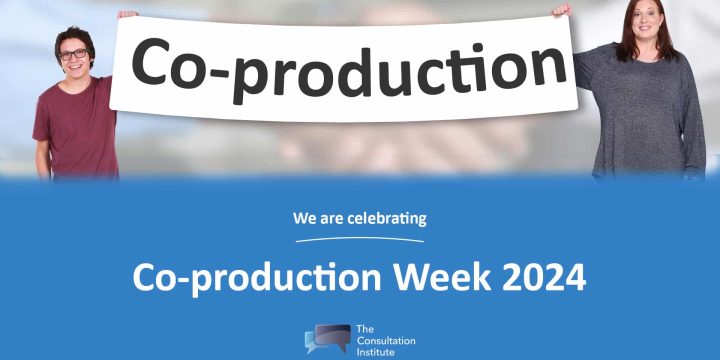News & Insights
Examining Co-production Part 3: The right relationships
In Part 1 I explored the right circumstances for co-production.
In Part 2 I explored the right preparation.
In this article I explore the right relationships. In future articles I will cover:
- The right support
- Bringing about behaviour change
- Measuring and evaluating
- Implementing
In this article, I explore findings on the relationships between participants in co-production and co-design processes such as staff, clinicians, and members of the public. I also explore relationships with senior leadership of the organisation hosting the co-production process, as well as the organisation’s relationships with local communities.
The Importance of Relationships
An exploration of quality improvement efforts found that using a co-design approach that focused on efforts that met both patients’ and health‐care professionals’ needs and priorities enhanced the quality improvement process. Exchanging stories and experiences in face‐to‐face meetings, co‐design discussions helped jointly prioritise improvement efforts; “the process allows patients to directly contribute to shaping the services they receive long‐term and realising their opinions were of value to clinical staff and hospital management.”. (Bergerum, 2019)
Insights from an international co-design project showed that a cross-cutting theme was the centrality of relationships to the entire codesign process. Event participants preferred a set of core principles rather than a series of rigid steps, and valued organisations taking time to fully engage, listen for understanding and not move forward until participants or communities were ready. Because of the vulnerability of many of the participants, the study found accountability and transparency to be particularly important. This meant formalising rules and expectations for the design work and being explicit about responsibilities for implementation. The study also found that ‘on-going communication from practitioners can promote trust and model the open attitude and willingness to learn that is needed for effective codesign’. (Gillian Mulvale, 2018)
A review of co-production by Healthwatch Suffolk highlighted a range of studies on the benefits:
- Skills, employability, personal qualities
- Autonomy, improved control over own health
- Confidence and self esteem
- Increased trust in services and professionals/trust network
- Increased understanding of the importance of keeping yourself healthy
However, the review also indicated that personal motivations are the least influential triggers for people to co-produce, and that is the more intrinsic value-based motivations, and circumstantial motivations that are more relevant drivers.
An interesting definition of co-production that they came across was ‘A mutual encounter that leaves people feeling energised in a space where active partnerships and a revelation of values takes place …’.
Factors that impact achieving co-production for citizens are:
- Citizen characteristics skills, intrinsic values, marital status, family composition, level of education
- Citizen awareness, feeling of ownership, and being part of something
- Social capital – an increased sense of social responsibility in the wider community
- Risk aversion by participating citizens
(Healthwatch Suffolk, 2021)
Communities and recruitment to co-production
Researchers have highlighted the need to better understand the contexts and backgrounds of people coming into co-production as this brings real value to the process. What keeps co-producers coming back is that co-production invests in strategies that develop the emotional intelligence and capacity of local communities, understanding the history and context of different groups, and respecting cultural differences.
Co-production brings value to local communities by:
- Allowing the understanding of the context and culture that people who use services, and co-produce them, come from.
- People making changes together; collective co-production.
- Providing people with the knowledge and opportunity to be trusted with decisions that affect them.
- Strengthening skills and confidence of more disadvantaged groups.
- Utilising existing community groups and networks.
“It has been found that some of the best examples of successful coproduction have occurred in the most challenging circumstances and when used with the most disadvantaged groups.” (Healthwatch Suffolk, 2021)
The foundation of effective co-design and co-production is continuous, repeated engagement with communities locally to aid recruitment of people into co-production processes.
The Consultation Institute has promoted continuous engagement as a strategy for a number of years (Ahmed, 2020) and some of our associates worked with an organisation called Hico to develop a continuous engagement framework for the West Wales Health & Care Partnership. (Inett, 2022)
O’Brien and Towell refer to six areas that need to be explored when initially engaging with people on a co-production exercise:
- How does it look to you?
- Talking together locally about what matters
- What does this mean to us?
- Making connections
- Counting in local assets
- Who is missing and how might we engage them?
(Towell, 2011)
The international study mentioned earlier also highlighted key areas of focus to ensure good relationships:
- Mutual Understanding
- Foster solid relationships among staff, decision makers and participants
- Understand different motivations, examples of what is possible and acknowledge needs that cannot be met
- Agree to a shared vision as a central purpose that guides the project
- User Centredness
- Focus on community/user-identified needs (not staff or system identified)
- Fully understand lived experience through conversation
- Prioritise people over process (objectives or timelines)
- Reciprocity
- Assess individual skills and capacity to participate, offer training and support that help build capacity
- Have a stable group to offer support that people feel part of
- Ensure meaning and purpose for participants and that process is making a difference
(Gillian Mulvale, 2018)
Organisations using Experienced Based Co-design (EBCD) have also used a range of techniques to initiate engagement with communities. For example, engaging with young people in local community settings; using yarning circles to understand the stories of Aboriginal and Torres Strait Islander people and communities; and choosing methods other than non-participant observation in mental health settings, where observation could be interpreted by some as being under surveillance. However, a 2014 review of EBCD studies internationally found that key tools were underutilised, and insufficient attention was paid to key components that lead to effective co-design. (Dimopoulos-Bick T. Dawda P, 2018)
Culture of Services
To enable the provision of co-production opportunities to service users by services, organisations need to see the value in facilitating it. Research suggests that when people play proactive roles as co-producers of public services, they become more involved, interested, and educated about issues, which in turn makes positive changes in their behaviours, perceptions, and attitudes as service recipients. Co-production can allow services to become catalysts and facilitators rather than simply providers, viewing its users as an invaluable component of service delivery. Some research suggests that in order to benefit fully from co-production, a service must undergo restructuring of existing processes like implementation, financing and monitoring to accommodate new practice.
A learning organisational culture begins with the understanding that no one person has all the answers, and so service providers need to actively seek the knowledge and expertise of service users, therefore taking the steps towards becoming a learning organisation.
An example of co-production with patients with chronic obstructive pulmonary disease showed how motivational interviewing from healthcare professionals supported having a more personalised and collaborative approach, which in return was recognised and valued by the patients, increasing their capacity for self-management.
Co-production supports professional development, including:
- Improvements in staff well-being.
- Increased recognition of the need for a better understanding of patient perspectives.
- Changes in attitudes toward working with patients as partners in quality improvement
- Opportunities to train others in the organisation in co-production
(Healthwatch Suffolk, 2021)
Power
By far the biggest issue in the success or failure of co-production is the power differential amongst participants.
A review of six EBCD projects in Australia highlighted the tension that surfaced when health professionals and service users came together to work collaboratively and were required to move out of traditional ways of working and mindsets. Although project teams co-produced a set of principles to guide collaboration and underpin the EBCD process, the principles were not enacted fully. Collaboration was made difficult and at times was hindered because values, attitudes, and perspectives about working together had not been shifted prior to joining together in the co-design stage. Although most health professionals instinctively accepted EBCD as a collaborative approach and valued lived-experience and working together, the transition away from more traditional and evidence-based quality improvement methodologies and power structures remained difficult.
These tensions signalled the importance of preparedness work needing to bring about a cooperative mindset and spirit of participation. This meant more than skills and techniques, but also the importance of recognising lived experience and expert knowledge within processes. It is deeply connected with identity and values.
Preparedness means having explicit dialogue and activities within early phases that attend to the need to shift the balance of power which often sits with health professionals. It also requires ways to foster recognition of lived experience knowledge as valued and therefore equal to other kinds of knowledge. For all six projects, transferring and sharing power was difficult and for the most part remained unsuccessful. This was perpetuated by existing vertical decision-making processes for approval and the allocation of resources, traditional power relations and professional hierarchies.
Services need to ensure they gain insights into contextual and environmental factors that may enable or hinder EBCD, including organisational readiness and culture, previous experience and success in collaborating with service users and dedicated resources. The report found that specific preparedness activities will be required with participants rather than relying on intrinsic motivations, which is notably different between health professionals and service users. Finding approaches that can identify and address biases ahead of time provided greater opportunities for the cooperative spirit to emerge.
The study identifies that the power balance can become more difficult when service users’ time is often expected to be voluntary rather than a form of recognition or payment. Service users can be less likely to participate in learning activities, which can impact their ability to participate in EBCD with equal voice, decision-making, and responsibility. Recognition and reciprocity can be through using formal methods and sometimes can also be met by achieving equal relationships between service users and the organisation. Finding ways where service users can play a greater role in driving the implementation effort is also important. (Tara L. Dimopoulos-Bick, 2019)
In the review of international case studies, power differentials were challenging in all the cases. For example, when working with adults with mental disorders, the Australian study noted that “challenges occurred in the dynamics between service users who had had negative experiences, and staff within working groups”.
Similarly in Scotland, tensions were noted due to dominance of the medical model vs a recovery model that places lived experience of service users at the centre because “… we are questioning that dominant medical world and they aren’t liking it— they are struggling with it.”
In England, adults with personality disorders felt highly vulnerable when reflecting on prior experiences of apparent powerlessness.
Power issues also had to be negotiated between youth with mental health issues and their former service providers prior to the codesign session.
Tensions also arose for domestic violence survivors when police services would only permit participation of women within the study.
Finally, in studies involving Indigenous communities, historical legacies of discrimination and harm, and “a deep on-going history of colonialism that still persists … within our health care system …,” can influence the acceptance of non-indigenous researchers and make research difficult in these communities
The study makes suggestions on how to empower communities and participants:
- Specify shared roles and responsibilities to empower community members
- Encourage participants to recognise that they are making a difference
- Constantly take stock of user perspective so staff do not take over, listen to voices of people with lived experience first who drive the process
- Consider that unpaid volunteers may feel greater freedom to voice opinions
- Adopt non-stigmatizing options for data sharing
- Power Sharing
- Formalise agreements for shared ownership of data and protection of Indigenous knowledge
- Communicate openly with respect to documents, data, and reporting
- Share leadership with a willingness to be challenged and directed
- Establish an expert panel to address stalemates and provide advice
(Gillian Mulvale, 2018)
The National Institute for Health and Care Research sets out an approach that co-producing research is principles – driven rather than being a fixed set of tools or techniques. It requires that relationships are valued and nurtured and that efforts are made to redress power differentials.
Their key principles are:
- Sharing of power – the research is jointly owned and people work together to achieve a joint understanding
- Including all perspectives and skills – make sure the research team includes all those who can contribute
- Respecting and valuing the knowledge of all those working together on the research – everyone is of equal importance
- Reciprocity – everybody benefits from working together
- Building and maintaining relationships – an emphasis on relationships is key to sharing power
Key features to manage this are:
- Establishing ground rules
- Continuing dialogue
- Joint ownership of key decisions
- A commitment to relationship building
- Opportunities for personal growth and development
- Flexibility
- Continuous reflection
- Valuing and evaluating the impact of co-producing research
(NIHR, 2021)
Another review of co-production projects found that where there is more awareness of people’s similarities as humans, rather than focusing on roles or job titles, this helps to break down the power imbalance. They state how challenging it can be to add co-production into an existing project or service and if professionals are choosing who, when and how to involve people, the power is arguably still weighted towards the service and not the user. They felt this should not discourage any services from striving to embed coproduction as the approach in the future, but careful consideration of managing power imbalances was needed. (Healthwatch Suffolk, 2021)
A review of a co-production project in Liverpool suggested separating staff and managers, when appropriate, to help manage power imbalances, and ensuring everyone in the group felt listened to. People needed to feel like they are in a psychologically safe space to feel at ease to speak up among others, which takes time. It also highlighted that disagreements between different stakeholders helped identify challenges early and may help develop solutions if well facilitated. (Benjamin JR Buckley, 2022) In a study of 305 cases of public environmental decision-making, it was found that in general, participation has a positive impact on environmental governance outcomes. And that delegation of power to participants is the most reliable predictor of positive outcomes. (Jens Newig, 2023)
Senior leadership support
This topic was explored in my first article on The Right Circumstances, but in terms of power imbalance issues, the New Economics Foundation advises: “Services can be most effective when people get to act in both roles – as providers as well as recipients, and devolve real responsibility, leadership and authority to users, and encourage self-organisation rather than direction from above.” (Foundation N. E., 2008)
A study looking at the challenges for staff making improvements in a hospital setting based on patient feedback found it to be a complex multi-tiered process and not something that ward staff can simply ‘do’. They found three requirements for it to be successful:
- Staff must exhibit normative legitimacy – the belief that listening to patients is a worthwhile exercise.
- Ward teams need adequate autonomy, ownership and resource to enact change. Some ward teams are able to make improvements within their immediate control and environment.
- Those who require interdepartmental co-operation or high-level assistance to achieve change, organisational readiness must exist at the level of the hospital otherwise improvement will rarely be enacted
(Laura Sheard, 2017)
The Australian study found that staff can also find it challenging to “loosen” the application of strict project management methods that rely on tight scope, deliverables, and timelines, indicating a need for authority to be given to do this by senior leadership. (Dimopoulos-Bick T. Dawda P, 2018)
The Point of Care Foundation states: ‘for lasting benefits to patients and staff, you need more than the approval of your senior leaders; you’ll need their active involvement and visible support.’ (Foundation P. o., 2013)
Conclusion
Relationships are key in any co-production and co-design process. Continuous engagement and viewing communities as assets is vital to ensure the process begins with openness, listening and mutual respect. The challenges of potential imbalances of power are clear and some techniques are provided to help manage this. To empower staff to address power issues, the active involvement and support of senior leadership is vital.
Bibliography
Ahmed. (2020). Is continuous engagement the right strategy for you? Retrieved from The Consultation Institute: https://www.consultationinstitute.org/is-continuous-engagement-the-right-strategy-for-you/
Benjamin JR Buckley, J. N. (2022). Multi-stakeholder perspectives on co-production: Five key recommendations following the Liverpool Co-PARS project .
Bergerum, T. J. (2019). How might patient involvement in healthcare quality improvement efforts work—A realist literature review.
Dimopoulos-Bick T. Dawda P, M. L. (2018). Experience-Based Co-Design: Tackling common challenges. JHD, 86-93.
Foundation, N. E. (2008). A Manifesto for Growing Core Economy.
Foundation, P. o. (2013). EBCD: Experience-based co-design toolkit.
Gillian Mulvale, S. M. (2018). Codesigning health and other public services with vulnerable and disadvantaged populations: Insights from an international collaboration,.
Healthwatch Suffolk, S. C.-p.-e. (2021). The Value of Co-Production Within Health And Social Care.
Inett. (2022). West Wales Continuous Engagement Framework. Retrieved from Steve Inett Consultancy: https://steveinettconsultancy.co.uk/collaborate/west-wales-continuous-engagement-framework
Jens Newig, N. W. (2023). Does stakeholder participation improve environmental governance? Evidence from a meta-analysis of 305 case studies.
Laura Sheard, C. M. (2017). The Patient Feedback Response Framework – Understanding why UK hospital staff find it difficult to make improvements based on patient feedback: A qualitative study.
NIHR. (2021). NIHR Guidance on co-producing a research project. Retrieved from https://www.learningforinvolvement.org.uk/content/resource/nihr-guidance-on-co-producing-a-research-project/?
Tara L. Dimopoulos-Bick, C. O. (2019). Anyone can co-design?”: A case study synthesis of six experience-based co-design (EBCD) projects for healthcare systems improvement in New South Wales, Australia.
Towell, O. &. (2011). Conversations about inclusive & sustainable communities: Six practices for creative engagement.



